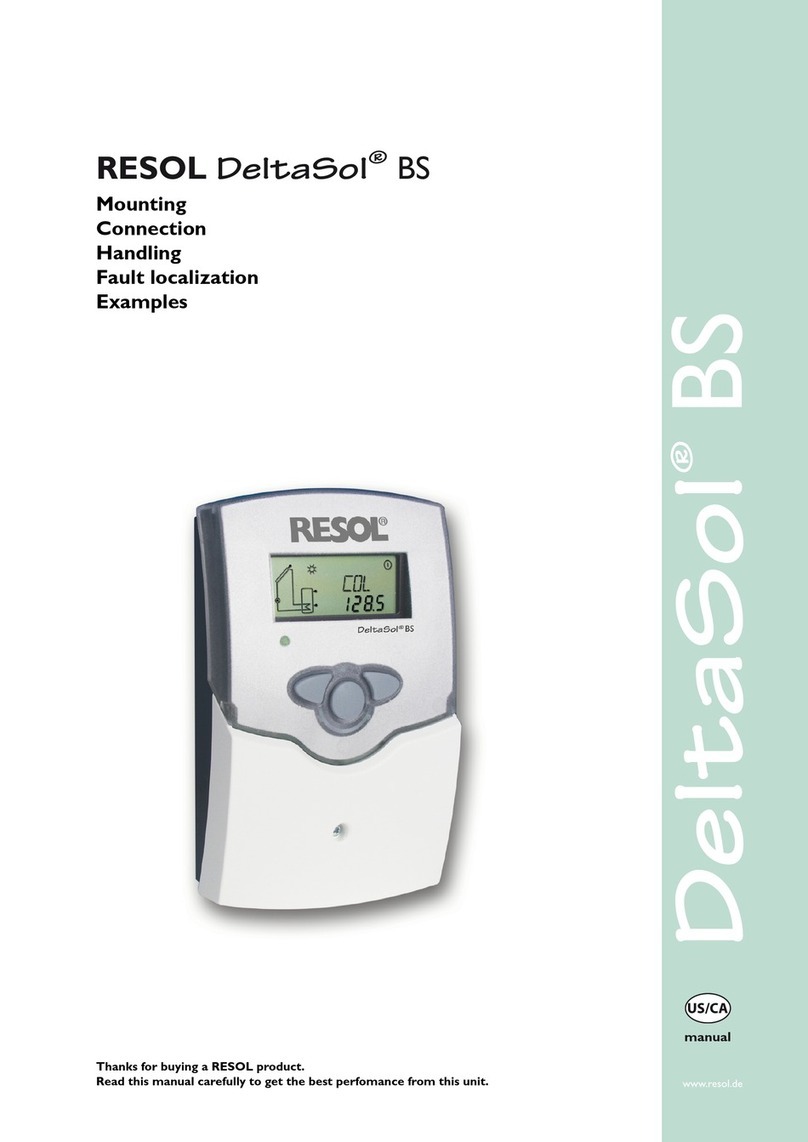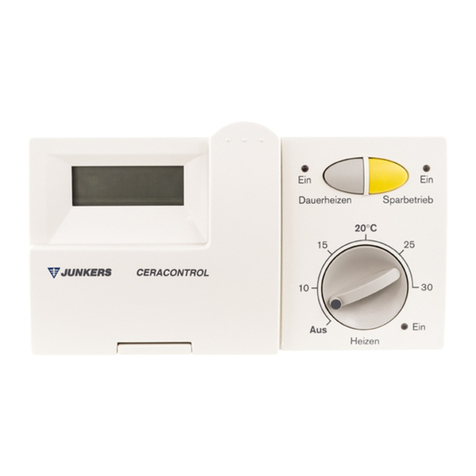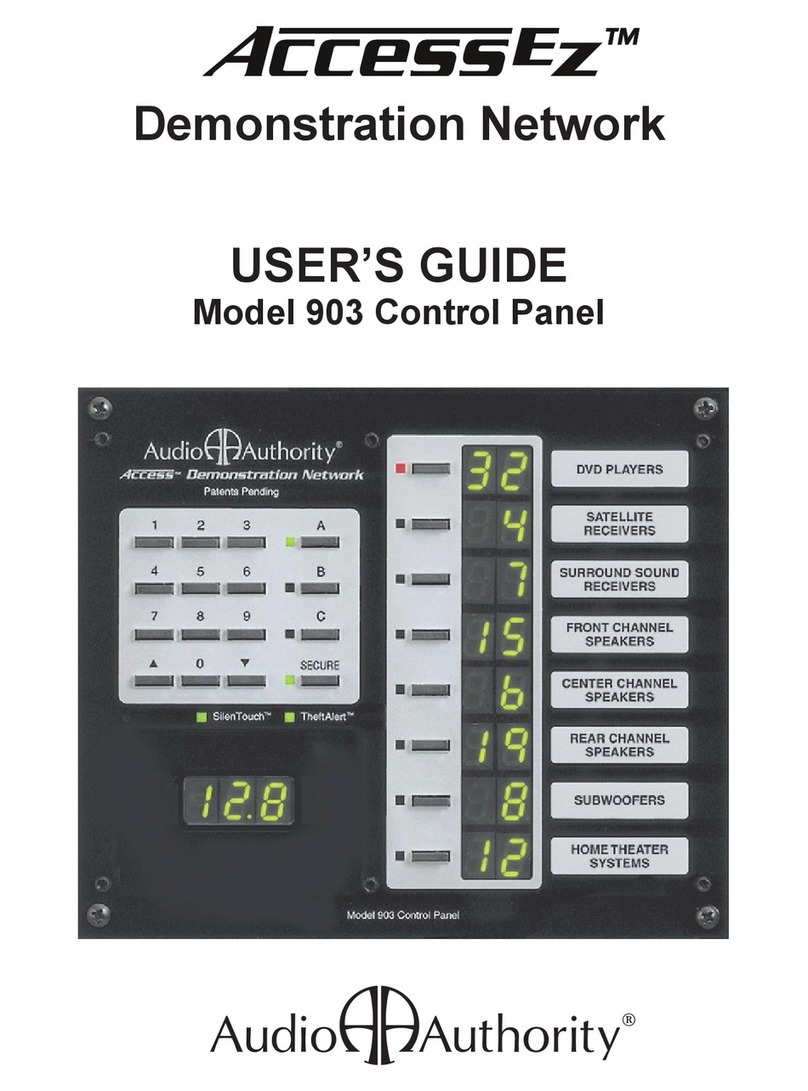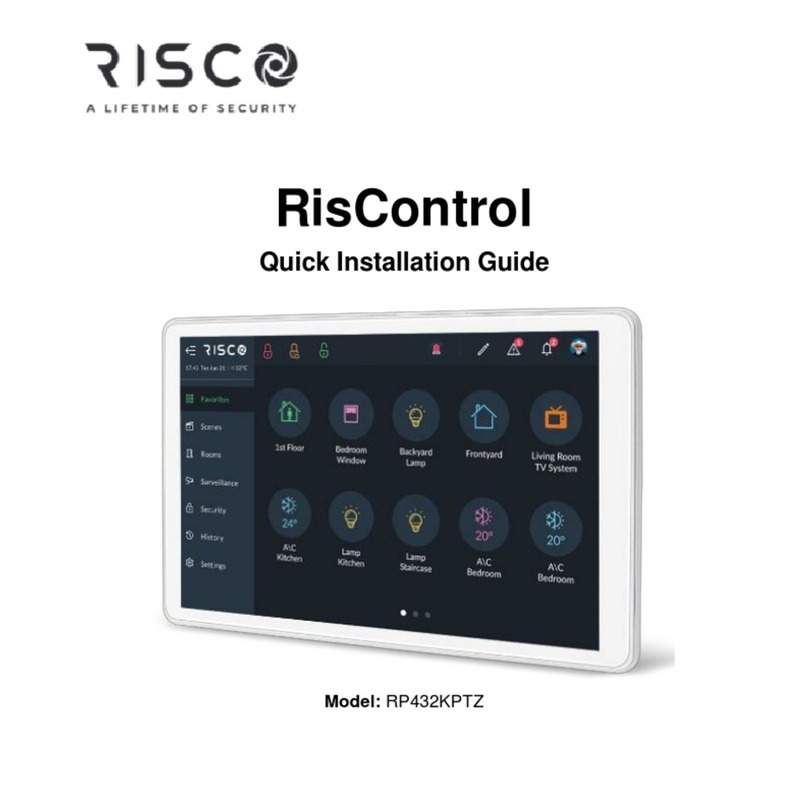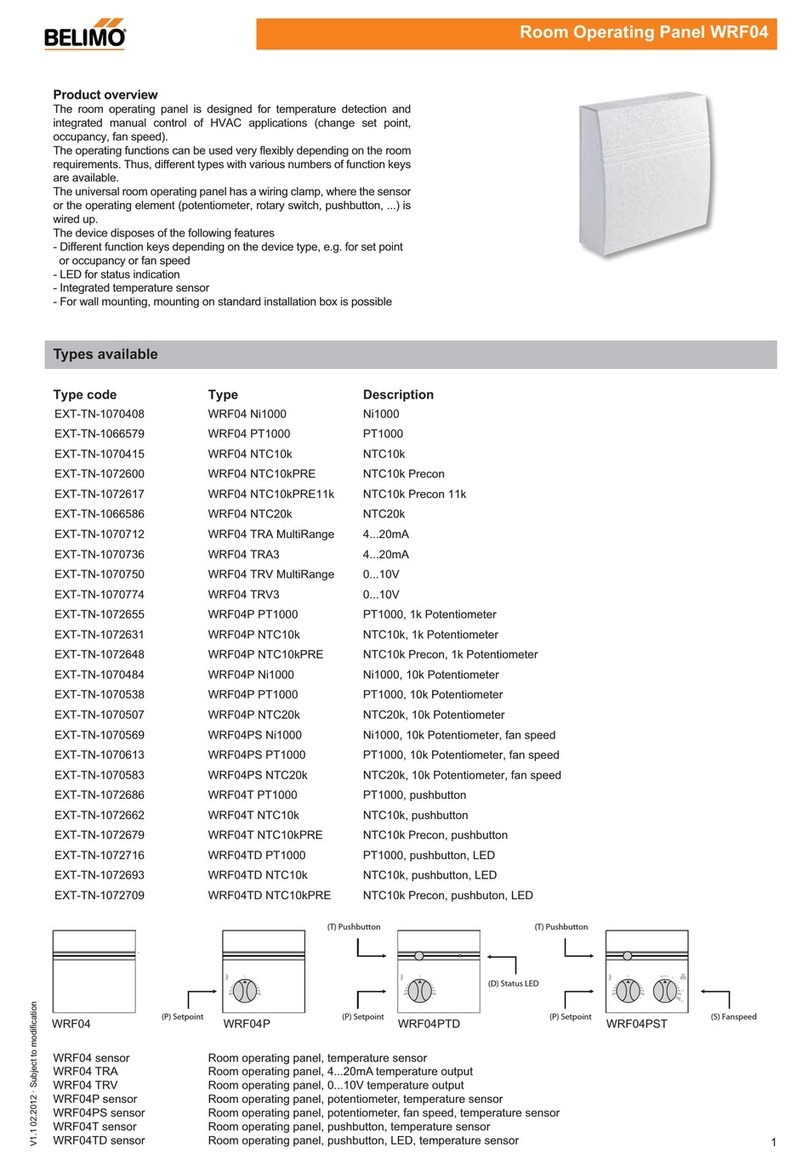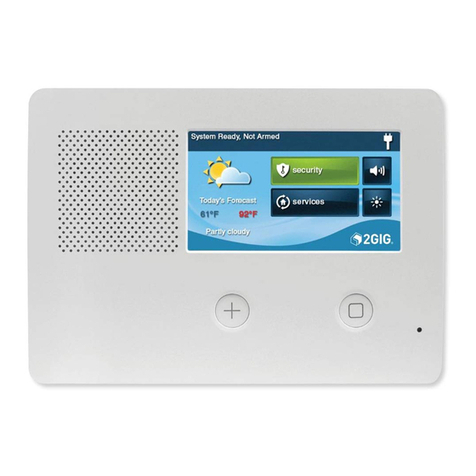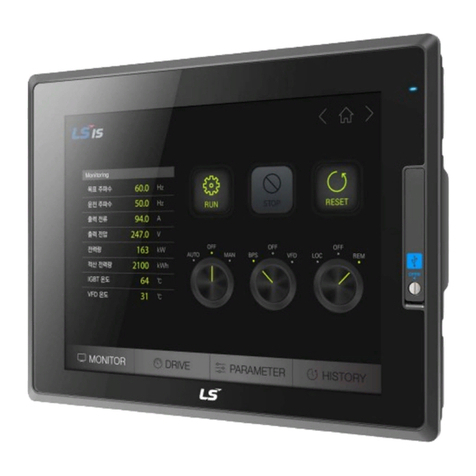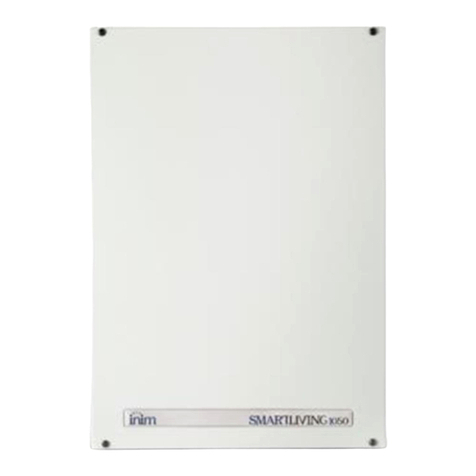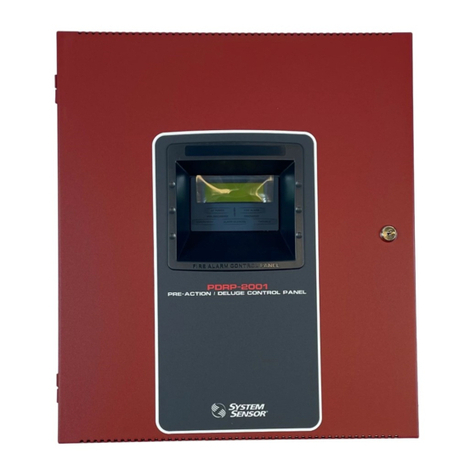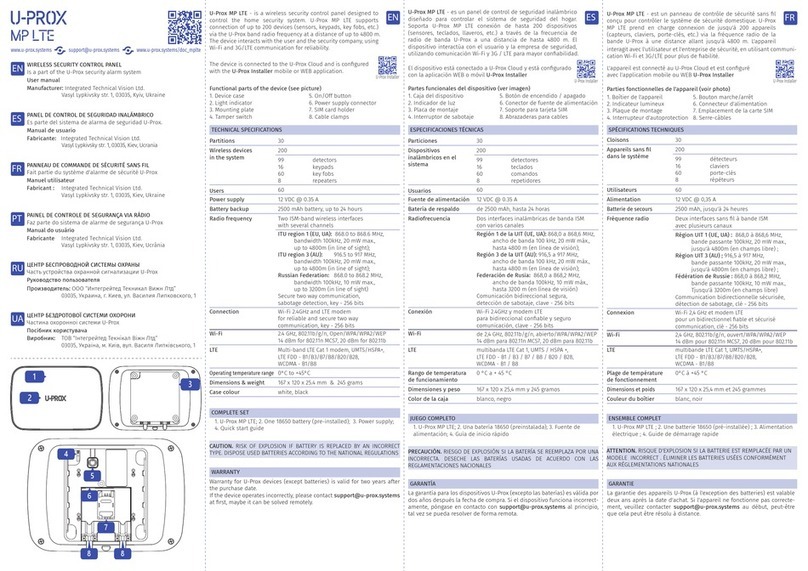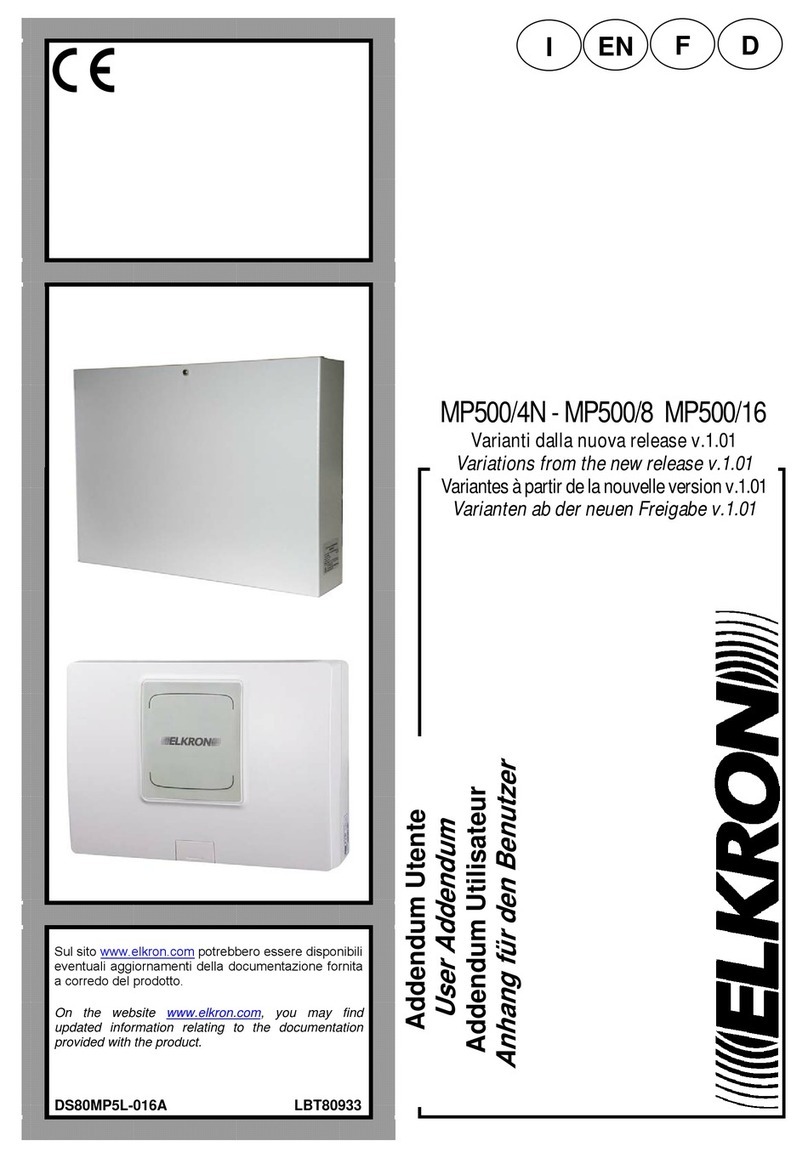BOSSLASER FTC61 Series User manual

Operators Manual for
FTC61 Series Control Panel
608 Trestle Point
Sanford, FL 32771
Toll-Free: (888) 652-1555
Local: (407) 878-0880
Fax: (407) 878-0837
WWW.BOSSLASER.COM

Panel Description
(1) LCD Screen
(2) Up Button
(3) Down Button
(4) Setup Button
(5) Enter Button
(6) Back Button
(7) Reset Button
Button Description
•Up Button: Set the state to control the cursor to move up
oFollow State - The follow up trimming height
oStandby State - The control operation of the cutting head up
•Down Button: Set the state to control the cursor to move down
oFollow State - Following the downward trim height
oStandby State - The control operation of the cutting head down
•Setup Button: Enter the setup interface
•Enter Button: Confirm the operation
•Back Button: Cancel the operation
•Reset Button: Reset operation, the reset is pressed, Z-Axis returns to the origin.
1
2
3
4
5
6
7
FTC61 SERIES MANUAL
Document Number: 855-910
Revision: 001 Revision Date: 6/1/2019
BOSSLASER - PAGE 1 of 12

Wiring Port Diagram
•-24V: 24V DC input negative
•PGND: DC power supply ground
•+24V: 24V DC input positive
•CA: Calibration / Perforated multiplexed signal. Dry contact signal.
•TR: Once connected, the FTC controls cutting head to set the following
position / began to follow. Dry contact signal.
oConnect: Start follow
oDisconnect: Stop follow. Back to the waiting position.
•0V: Input signals in public 0V
•ZUP: On the move signals, follow the process
oSignal connected system controlling the cutting head.
•ZDN: To move the signal, follow the process
oSignal connected system controlling the cutting head down.
•0V: Input signals in public 0V
•UL: Z-Axis maximum signal. Dry contact output signal.
oConnect: Upper Limit
oDisconnected: No Limit
•LL: Z-Shaft lower signal. Cutting head dropped to the lowest level.
•COM: Output signal of the common terminal. Voltage range: 0 ~ 36 V
•K1: Anomaly alarm output signal. Notify CNC system downtime.
oConnect: System failure
oBreak: Normal
•K2: Follow the signal to / Calibration complete. Signal (Closed 1s)
oAccess: Reached the following location
oDisconnect: No position is to follow
•K3: Piercing signal. Dry contact output signal.
oAccess: Reached the hole position
oDisconnect: "No" to the piercing location
•SG: Shielded signal cable
•PUL (+): Motor control pulse signal
•PUL (-): Motor control pulse signal
•DIR (+): Motor direction control signal
•DIR (-): Motor direction control signal
•Aviation plug: Capacitance signal.
•GND: Computer communication serial port RS232
•RX: Computer communication serial port RS232
•TX: Computer communication serial port RS232
Port Definition
FTC61 SERIES MANUAL
Document Number: 855-910
Revision: 001 Revision Date: 6/1/2019
BOSSLASER - PAGE 2 of 12

Light Indicator Descriptions
•RUN (Green Light)
oFlashing: Works properly
oOften off: System exception
•ALM (Red Light)
oOften off: Works properly
oAlways bright: System alarms
Note: If the system alarm is enabled and want to eliminate it, you will need to reboot.
Main Interface Description
•Operating Status: Display controller is currently running.
oEmergency Stop: Follow the process; system. If there are alarms into the
emergency stop State. Troubleshooting completed by compound key, the
system enters the waiting state
oWait bit: The system is powered on, first began entering the wait after the
completion of State
oPerforation: When a piercing signal (BH) after closure, the system
reached the hole position.
oFollow-bit: Follow signals (TR) after closure, the system reached the
following locations.
•Follow the height: Show follow height
oThe distance between the floating head and the plate
•Signal Strength: Displays the current capacitance of signal value.
oThe closer the nozzle is, the smaller the capacitance
•CA/TR/UL/LL: Displays the current input signal status.
oWhen an input signal is switched, the signal back on the LCD will display
" * ". The input signal is disconnected when a " * " disappears.
Setting Interface
Press the "set" key to go to the "settings" as shown in the following picture:
FTC61 SERIES MANUAL
Document Number: 855-910
Revision: 001 Revision Date: 6/1/2019
BOSSLASER - PAGE 3 of 12

Parameters Configuration
Select "configuration" and press "confirm" button, enter the parameters. FTC61
parameters, the user can up / down arrow key to page, select the parameter you want to
set, followed so as to achieve the best results.
Parameters Description
•Speed Stalls: Set the speed of the follower
oFactory settings: Third gear
oOptional settings: One file to six files
oThe higher the gear, the faster the speed. With a stepper motor, it is recommended
to select the second gear speed.
•Sensitivity Level: Set the sensitivity level of the follower reaction
oFactor settings: 10
oOptional settings: 1 - 30
oThe smaller the value, the lower the sensitivity
•Follow the Height: Set the following height
oFactor settings: 1.0mm
oOptional settings: 0.4 - 5.0mm
oProcess adjustment
•Follow the Tolerance: The parameter is followed by the accuracy of the response
oFactor settings: 50um
oOptional settings: 0 - 500um
oThe larger the value, the more stable the results will follow, but poorer
repeatability; significantly cutting the zigzag sense. It is recommended to set at/
between 50 to 150.
•Waiting for Height: Set the cutting head to follow the completion of the docking height.
oFactor settings: 20mm
oOptional settings: 10-99mm
•Perforation Method: Set the punch mode
oFactor settings: Segmented perforation
oOptional settings: Segment perforation / progressive perforations
•Perforation Height: Set the hole height
oFactor settings: 3.0mm
oOptional settings: 1.0 - 5.0mm
FTC61 SERIES MANUAL
Document Number: 855-910
Revision: 001 Revision Date: 6/1/2019
BOSSLASER - PAGE 4 of 12

•Perforation Speed: Set the punching speed
oFactor settings: 1.0mm
oOptional settings: 0.1 - 9.9mm
oProgressive perforation is effective
•Touch Board Signal: Set the signal size when touching the board.
oFactor settings: 1K
oOptional settings: 1 - 499K
oThe value must be slightly larger than the actual touch panel signal; can not
easily be changed
•Hit Board Delay: Set the duration of the collision plate
oFactor settings: 200ms
oOptional settings: 10 - 500ms
oThe metal sheet touches the contact duration for more than the value.
•Touch Up the Board: In the waiting position, jogs when the touch board signal once,
the Z-Axis immediately lifts a distance to avoid the workpiece and objects.
oFactor settings: No
oOptional settings: Yes / No
oThis parameter is invalid in the following state.
•Alarm Lift: In the following state when the touch panel has alarm FTC61 Z-Axis
corresponding to the operation made.
oFactor settings: Back to the original
oOptional settings: Back to the original / Waiting / Follow
oBack to the original point. Wait: return to wait bit. Follow: Z Axes continue to
follow
•Screw Pitch: Set screw pitch (Z-Axis)
oFactor settings: 10mm
oOptional settings: 1 - 50mm
oThe setting must match Z actual screw pitch consistent.
•Per Revolution: Set the motor subdivision
oFactor settings: 4000
oOptional settings: 400 - 10000
oThe set value must be consistent with the Z-Axis motion control drive.
•Calibration Multiplexing: Set the input signal for the calibration / perforation
oFactor settings: Calibration
oOptional settings: Calibration / Perforation
oOptional input CA. Calibration / Perforation signal.
•Device Address: Set the local address
oFactor settings: 1
oOptional settings: 1 - 99
•Communication: Set the communication rate
oFactor settings: 9600
•Restore Factory: Enable the factory reset function
oFactor settings: No
oOptional settings: Yes / No
oSelect "Yes," the system parameters restore factory settings
•Language Selection: Set the display language
oFactory settings: Chinese
oOptional settings: Chinese / English
oSupport Chinese / English display
FTC61 SERIES MANUAL
Document Number: 855-910
Revision: 001 Revision Date: 6/1/2019
BOSSLASER - PAGE 5 of 12

Touch Panel Settings
Select the touch panel set. Press OK key. Enter the setting interface; when floating head shift to
plate press Enter after exposure setting. The current signal is set to signal touch plate.
Alarm Information
The alarm information mainly records the contents of the product alarm (as shown below).
Automatic Calibration and Follow-Up Control Function
FTC61 capacitance formed between the metal workpiece and the laser nozzle is measured by a
dedicated integrated chip and a small capacitance measurement AD conversion circuit. Capacitance
using the following formula to calculate the distance between the nozzle and the workpiece, thereby
floating the Z-Axis real-time control, to ensure that the relative distance between the nozzle and the
workpiece constant. The calculation formula is...
where,
•C: Capacitance
•ε: Dielectric Constant
•S: Laser machining nozzle member and the metal alignment area
•d: The distance between the laser nozzle and the metal workpiece
FTC61 supports automatic calibration function and the process is quick and easy.
Floating Head Calibration
Select the floating head calibration. Press the Enter key. The system starts to automatically calibrate.
(Confirm)
(Cancel)
FTC61 SERIES MANUAL
Document Number: 855-910
Revision: 001 Revision Date: 6/1/2019
BOSSLASER - PAGE 6 of 12

Distance Measurement and Signal Detection Function Parameter
•Capacitance Detection Range
o0.5PF ~ 1NF
•Capacitance Detection Accuracy
o±0.01PF
oRelated to the working environment
•Distance Measurement Range
o0.4mm ~ 5.0mm
oThe structure of the laser nozzle
•Distance Measurement Accuracy
o0.01mm
oFor stationary leveling workpieces
•Sampling Frequency
o2kHz
o2000 times per second
•ADC Accuracy
o12 bit
oDetection range: 0V ~ 3.3V
Segmented Perforation Function
The perforation function is mainly used in the cutting of thick plates, which can effectively
control the probability of bursting in the cutting process and improve the cutting quality.
FTC61 provides a way to "punch" signal input, all the way through the hole in the signal output.
When the CNC system closes the perforation signal, the FTC61 controller controls the floating
head to reach the perforation position (the height can be set) and begin perforation.
FTC61 SERIES MANUAL
Document Number: 855-910
Revision: 001 Revision Date: 6/1/2019
BOSSLASER - PAGE 7 of 12

Input Signal Detection Function
For closer cooperation with the laser system, the FTC61 extends the 6-way dry contact signal
input detection while completing the closed-loop control. It can be used for signal detection such
as calibration (CA) / perforation (BH), follow (TR), move up (ZUP), move down (ZDN), upper
limit (UL), and lower limit (LL).
Switch Signal Detection Parameters
•Calibration (CA) / Perforation (BH): Dry contact input signal, connected to valid
oEnter the dry contact signal
oCalibration Signal ON: Starts the floating head calibration.
oPunching Signal ON: Start punching
oBreak: Stop perforation.
oThis signal needs to be turned on before the following signal
•Follow (TR): Dry contact input signal, connected to valid
oWhen there is a follower signal, control the cutting head to reach the following
height. Disconnect stops and returns to the wait bit.
•Movable Point (ZUP): Dry contact input signal, connected to valid
oThe signal is turned on and the system controls the cutting head to lift.
•Jogging Lower (ZDN): Dry contact input signal, connected to valid
oThe signal is turned on and the system controls the cutting head to drop.
•Upper Limit (UL): Dry contact input signal, connected to valid
oWhen the upper limit signal is inputted, the display "upper limit" indicator
light is on and the cutting head stops moving upward and can be moved down
or reset by manual operation to separate the cutting head from the upper limit.
•Lower Limit (LL): Dry contact input signal, connected to valid
oWhen the lower limit signal is inputted, the display "lower limit" prompt is on
and the "hard limit alarm"is displayed. At the same time, the alarm output port
K1 and COM are connected. The user can customize the alarm output port K1
COM to connect with a CNC system.
FTC61 SERIES MANUAL
Document Number: 855-910
Revision: 001 Revision Date: 6/1/2019
BOSSLASER - PAGE 8 of 12

Abnormal Alarm Protection Function
FTC61 controller failure may occur during the actual work of both sound alarm and prompt
protection measures, can effectively prevent the misuse harm to staff and equipment. Mainly
include: upper limit alarm, lower limit alarm, soft lower limit alarm, collision board alarm,
dropped alarm.
Alarm List
•Hard Lower Limit Alarm
oTriggering conditions: Z-Axis touch travel limit switches
oRelease Method: Control the cutting head to move up to the normal mechanical
displacement range
•Touch Board Alarm
oTriggering conditions: (1) Metal sheet (or body) collision cutting head duration
exceeds the set value. (2) The signal transmission line is not connected to the control
box.
oRelease Method: (1) The system is in the waiting state position three seconds after
the alarm disappears. (2) Acknowledgment signal transmission line control box,
connected between the amplifier correctly.
•Signal change is small
oTriggering conditions: The amount of signal change during calibration is too small
(less than 200).
oRelease Method: Check the ground condition is good, to ensure that the amplifier,
capacitor sensor nozzle connection fastening.
FTC61 SERIES MANUAL
Document Number: 855-910
Revision: 001 Revision Date: 6/1/2019
BOSSLASER - PAGE 9 of 12

To ensure the safety of the person and the equipment, please follow the instructions
on the equipment and all the safety precautions described in the manual when
operating and maintaining the equipment. The "Safety Warnings," Cautions" and
"Descriptions" matter in the manual do not represent all the safety matters that
should be followed and only as a supplement to all safety precautions.
Observe All Safety Precautions
Comply with Local Regulations and Regulations
When operating the equipment, observe local regulations and specifications.
Personnel Requirements
Personnel responsible for the maintenance and operation of the equipment must
be read and operated with the necessary information and safety precautions
before operating and maintaining the equipment.
Daily Maintenance
•Regularly check the coaxial cable connection (for tightness) between the
capacitive sensing element (nozzle) and the FTC. If it's loosen or not tight, it
should be tighten, otherwise it will affect the measurement results.
•Regularly check the capacitance sensor (nozzle) oxidation and wear. Severe
oxidation or wear should be replaced promptly, otherwise it will affect the
measurement results.
•Regularly check the status of the FTC indicator. If the ALM light is lit, it
indicates that the FTC part has failed.
•Regularly do the floating head calibration once a day.
FTC61 SERIES MANUAL
Document Number: 855-910
Revision: 001 Revision Date: 6/1/2019
BOSSLASER - PAGE 10 of 12

Troubleshooting
•Problem: The motor is running but the drive structure does not move.
oPossible Causes: The connection between the motor and the drive structure is loose.
oApproach: Check the connection between the motor and the drive structure after the
system is powered down.
•Problem: The cutting head runs in the opposite direction to normal logic.
oPossible Causes: The direction of the control signal DIR signal is reversed or a signal
is not connected firmly. Between the motor and the drive AB.
oApproach: After the system is powered down, adjust the connection between the
motor and the drive.
•Problem: The system can not control the cutting head to follow the specified height after
entering the normal working condition.
oPossible Causes: The system does not detect a follow-up signal.
oApproach: Check whether the laser switch signal output of the laser system is normal.
Is this signal properly connected to the FTC port?
•Problem: After the system has entered the normal working condition, close the follower
signal (TR), cut the head up, or shake up and down.
oPossible Causes: (1) The capacitor signal line connection loose. (2) The motor driver
line is loose. (3) The signal strength has abnormal changes. (4) The workpiece is in
poor contact with the amplifier housing.
oApproach: Check if the connection between the capacitor signal cable and the cutting
head is loose. Check whether the connection between the capacitor signal cable and
the preamplifier is loose. Check whether the motor driver cable is loose and the
resistance of the workpiece and the amplifier shell should be less than 2 ohms. If the
signal strength changes abnormally, please re-calibrate.
•Problem: The system follows the height deviation from the set value too far.
oPossible Causes: The screw pitch / per revolution is not the same as the actual value.
oApproach: Set the screw pitch / per revolution to the actual value setting.
•Problem: Cutting head in the follow-up height up and down the shock.
oPossible Causes: (1) FTC and metal processing parts bad grounding. (2) Nozzle and
metal parts short circuit. (3) The nozzle and the FTC coaxial cable connection
loosening. (4) Follow the tolerance set too small.
oApproach: (1) Check whether the FTC grounding point with the metal processing
parts connected well. (2) Check the capacitance sensor (nozzle) is short with metal
parts (3) Check the capacitance sensor (nozzle) and the FTC coaxial cable is connected
between the fastening. (4) Will be set to follow the tolerance.
•Problem: The cutting head has overshot before being followed.
oPossible Causes: (1) The motor rigidity is insufficient. (2) The motor speed is too fast.
oApproach: (1) Adjust the motor drive rigidity or current. (2) Reduce the speed stalls
FTC61 SERIES MANUAL
Document Number: 855-910
Revision: 001 Revision Date: 6/1/2019
BOSSLASER - PAGE 11 of 12

Troubleshooting (cont.)
•Problem: When the floating head is calibrated, it indicates that the sensor has failed
oPossible Causes: (1) The signal transmission line / capacitor radio frequency line bad.
(2) Ceramic ring contact bad. (3) The front amplifier is damaged.
oApproach: (1) Replace the signal transmission line / capacitor radio frequency line after
re-calibration. (2) Re-install the ceramic ring. To ensure that the nozzle and the ceramic
ring connected closely (measuring capacitance signal line and copper nozzle resistance
should be less than 10 ohms and stable resistance without fluctuations). (3) Replace the
preamplifier re-calibration.
•Problem: Floating head calibration failed
oPossible Causes: The Z-Axis is at the upper limit
oApproach: Re-calibrated from the upper limit
•Problem: Floating head is displayed as "Poor"
oPossible Causes: (1) FTC and metal processing parts bad grounding. (2) Other inductive
load interference
oApproach: Check the equipment grounding. (2) Stay as far away as possible from large
inductive loads, such as a high-power motor, high-power air conditioning, etc.
•Problem: The touch panel signal is not detected.
oPossible Causes: Floating head and the workpiece is not grounded, or poor grounding.
Ceramic ring contact is bad.
oApproach: Check the grounding conditions of each part (measuring capacitance signal
line and copper nozzle resistance should be less than 10 ohms and stable resistance
without fluctuations).
•Problem: Close the "COM" and "TR" after the cutting head does not follow the action.
oPossible Causes: (1) Bad contacts with "COM" and "TR." (2) "Running Status" shows
"Emergency Stop." (3) The motor driver alarm or line contact is bad.
oApproach: (1) Check whether the switch is normal or does not have a bad contact. (2)
Press the FTC61 "Reset" button to cancel the alarm.
FTC61 SERIES MANUAL
Document Number: 855-910
Revision: 001 Revision Date: 6/1/2019
BOSSLASER - PAGE 12 of 12
Table of contents
Other BOSSLASER Control Panel manuals



